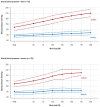Exercise Testing in Sports Medicine
- PMID: 29968559
- PMCID: PMC6050434
- DOI: 10.3238/arztebl.2018.0409
Exercise Testing in Sports Medicine
Abstract
Background: Bicycle and treadmill exercise tests are used in sports medicine and occupational medicine to detect latent disease, to monitor treatment, and to measure patients' physical performance ability and reserve. In this review, we describe the indications, contraindications, and manner of performance of these tests, along with the variables tested, criteria for evaluation, (sub)maximal stress, and the factors that affect these tests, including age, sex, and medications.
Methods: This review is based on pertinent articles retrieved by a selective literature search and on the ergometry guidelines of four medical specialty societies.
Results: The proper performance of ergometric stress tests calls for preparation and monitoring by qualified staff as well as standardized testing conditions. Ergometric studies are indispensable as a clinical diagnostic method for the early recognition of disease, for follow-up over time, and for individual counseling. The patient's maximal achievable performance is a predictor of morbidity and mortality. Among the variables that can be measured in the submaximal performance range, the respiratory rate, heart rate, and lactate performance curves are more accurate prognostic predictors than the so-called threshold values (physical working capacity, anaerobic-aerobic threshold). Ergometric stress tests can be used to detect (among other conditions) latent hypertension, pulmonary diseases (e.g., exertional asthma), pabnormal ECG changes, and cardiovascular disorders (e.g., ischemia, arrhythmia, congestive heart failure). The ergometric findings are influenced by the choice of stress-inducing protocol. They provide important information for the planning and monitoring of exercise training and for the treatment of persons suffering from diverse physical conditions, as well as for leisure-time athletes. They are less suit- able for use in the design of training programs for high-performance athletes.
Conclusion: Ergometric stress tests provide important data in clinical and preventive medicine. The findings are often difficult to interpret because of the wide range of normal findings, the use of different stress-inducing protocols, and the lack of gen- erally accepted reference values. The establishment of a nationwide fitness and health registry for ergometric data would be very helpful for the individualized inter- pretation of test findings and for the monitoring of exercise training and therapy.
Figures




Comment in
-
Validity of Exercise ECG.Dtsch Arztebl Int. 2018 Oct 26;115(43):731. doi: 10.3238/arztebl.2018.0731a. Dtsch Arztebl Int. 2018. PMID: 30518472 Free PMC article. No abstract available.
-
Degree of Physical Performance Capacity.Dtsch Arztebl Int. 2018 Oct 26;115(43):731. doi: 10.3238/arztebl.2018.0731b. Dtsch Arztebl Int. 2018. PMID: 30518473 Free PMC article. No abstract available.
-
Exercise Testing in Sports Medicine.Dtsch Arztebl Int. 2018 Oct 26;115(43):731-732. doi: 10.3238/arztebl.2018.0731c. Dtsch Arztebl Int. 2018. PMID: 30518474 Free PMC article. No abstract available.
References
-
- Löllgen H, Erdmann E, Gitt AK, editors. Springer. Berlin, Heidelberg: 2010. Ergometrie. Belastungsuntersuchungen in Klinik und Praxis.
-
- Pescatello LS. ACSM‘s guidelines for exercise testing and prescription. Baltimore: Lippincott Williams & Wilkins. 2014
-
- Ross R, Blair SN, Arena R, et al. Importance of assessing cardiorespiratory fitness in clinical practice A case for fitness as a clinical vital sign: a scientific statement from the American Heart Association. Circulation. 2016;134:e653–e699. - PubMed
-
- Löllgen H. Kardiopulmonale Funktionsdiagnostik. Nürnberg: Novartis Pharma. 2005
Publication types
MeSH terms
LinkOut - more resources
Full Text Sources
Other Literature Sources
Medical

